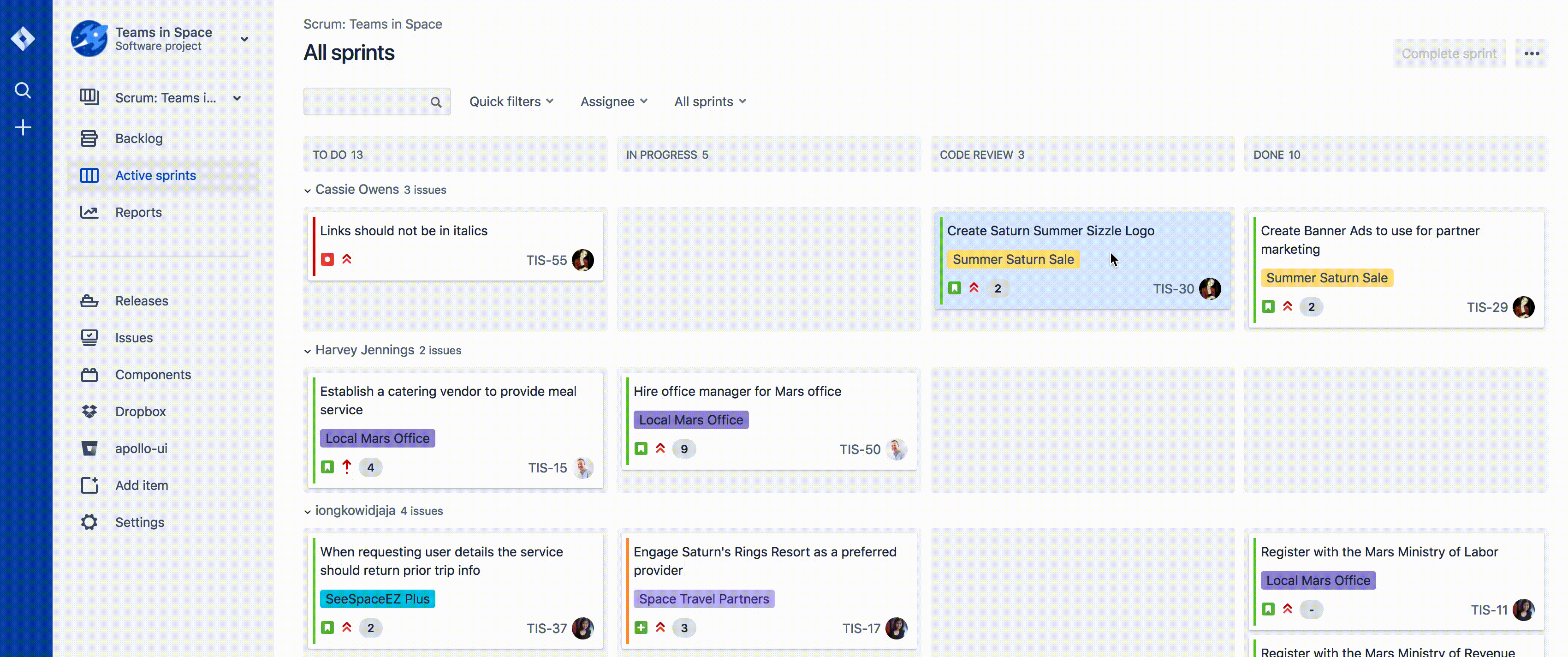What is a sprint review?
A sprint review meeting is a fundamental ceremony in Agile development, specifically within the Scrum framework. It marks the end of a sprint—typically a time-boxed period of two to four weeks—during which the development team delivers a potentially shippable increment of product functionality.
In a sprint review, the development team and stakeholders gather to review and demonstrate the work completed during the sprint. This provides an opportunity to showcase the features developed, gather feedback, and ensure alignment with the product vision and requirements.
What is the main purpose of a sprint review?
The main goal of a sprint review is to gather feedback and ensure transparency in the next steps of the development process. It has several key objectives:
Demonstration of completed work: The development team demonstrates the features completed during the sprint to key stakeholders, including the product owner, customers, and other relevant parties.
Feedback collection: Stakeholders provide feedback on the demonstrated features, enabling the team to adjust and prioritize work effectively in subsequent sprints.
Alignment with product vision: The sprint review ensures the work completed aligns with the overall product vision and objectives. It helps validate that the development efforts and sprint goals are moving in the right direction.
Celebration of achievements: It provides an opportunity to celebrate the development team's accomplishments and acknowledge their hard work and dedication.
Identification of improvements: Through discussions and observations during the sprint review, areas for improvement in the development process can be identified and addressed in future iterations.
In short, the sprint review promotes collaboration, transparency, and continuous improvement within the Agile development framework. It fosters a culture of open communication, collaborative working sessions, and shared responsibility for the product's success.
Sprint review vs retrospective
Sprint reviews are not retrospectives, but what is a sprint review? A sprint review demonstrates the hard work of the entire Scrum team: designers, developers, and the product owner. At Atlassian, we like to keep our sprint reviews casual.
Team members gather around a desk for informal demos and describe their work for that iteration. It's a time to ask questions, try new features, and give feedback. Sharing in success is an important part of building an agile team.
Let's discuss why the team's "definition of done" is important to this agile ceremony.
Step 1: Define 'done'
As a regular user of Jira, user, nothing is more satisfying than moving a task from “code review” to “done.” That transition represents the completed work we set out to accomplish as a team. Done and done!

Crossing the finish line and completing work requires good planning, a clear "definition of done," and focused execution. Most of this happens during sprint planning, but teams need to do a little more than planned to have a successful sprint review and sprint. They must develop a clear culture of delivering work and what it means to be “done."
A culture of delivery
Effective teams bring clear processes and development culture to each project and every work item. Use these questions to assess your process and make sure it's working optimally:
- Are stories well-defined by the product owner, designer, and engineering team before implementation?
-
Does everyone understand the team's engineering values and culture?
-
Are there clear definitions and requirements around code review, automated testing, and continuous integration to encourage sustainable, agile development?
-
After the team completes a story, do any bugs surface? In other words, does ‘done’ really mean ‘done?’
The team's culture around quality and completion should rise above every user story, engineering work item, and bug. This culture is reflective of how the team approaches and delivers software.
Defining ‘done’ on each work item
A clear definition of ‘done’ helps teams focus on the end goal for each work item. When the product owner adds work to the team’s backlog, defining the acceptance criteria is a key part of his or her process. What does it mean for a user story to be complete?
At Atlassian, the Jira team tracks acceptance criteria and testing notes in line with the rest of the user story inside of Jira. That way, the entire team has a clear view of success on every issue. What are acceptance criteria and testing notes?
- Acceptance criteria: Metrics the product owner uses to confirm the story is implemented to their satisfaction.
-
Testing notes: Short, focused guidance from the quality assistance team that enables the development engineer to write better feature code and automated tests.
Well-defined issues during implementation allow everyone to be successful. With Jira, it's easy to add fields in line. As an administrator, click the admin button on the issue.
Step 2: Celebrate the team
At Atlassian, one of our core values is to “play, as a team.” Sprint reviews are a great time to celebrate the team and everyone’s accomplishments during an iteration. We typically host them on Friday afternoons, while everyone in the office winds down before the weekend.
Sprint reviews are not synonymous with retrospectives, so make sure to host the sprint review after an iteration, but before your retrospective. External participants are always welcome to join, but the meeting usually consists of the product owner, the full development team, and the scrum master. As a best practice, we recommend spending 30 minutes to an hour for each iteration in the meeting.
We love sprint reviews because they protect the health and morale of the team. Sprint reviews are all about team building. The review isn’t adversarial, it’s not an exam—it’s a collaborative event across the team in which people demo their work, field questions, and get feedback.
“Encourage team ownership during the sprint review by having different team members demonstrate the functionality,” suggests Atlassian’s Modern Work Coach Mark Cruth. “If you use Feature Leads, this is a great way for them to demonstrate their hard work leading the effort.”
If a sprint review doesn’t become a positive activity across the team, it may be indicative of:
- The team taking on too much work and not completing it during an iteration
“Sprint reviews are a great way to encourage teams to break down their work into small, meaningful deliverables,” adds Cruth. “Avoid reviewing unfinished work - as the Agile Manifesto puts it, the goal is working software!”
-
The team struggling with existing technical debt
-
Features not being developed sustainably to ensure new bugs are not introduced into the codebase
-
The team’s development practices aren’t as tuned as they could be
-
The product owner is changing priorities within an iteration, and the development team is sidelined by scope creep
Note: Every team has a difficult iteration sometimes. Take the time to understand why an iteration changes in the team's retrospective and create a plan to address future issues.
Step 3: Reach across geographies
Companies with distributed teams have special challenges around scaling agile ceremonies across geographies. Sprint reviews are no exception.
The Jira team, for example, has members worldwide, from Sydney to Gdańsk to San Francisco. Even though we're distributed, sprint reviews are an important part of our team culture. Team members create informal videos and share them on a Confluence page for the entire team to see.
“Use tools like Loom to record your review and gather feedback from others around the globe,” Cruth explains. “We work in an async world, so approach sprint reviews from the lens of async collaboration.”
These informal videos keep everyone up-to-date on the progress of development projects despite time differences. Seeing a feature demo first-hand by the developer strengthens the team in two ways:
-
Product Understanding: The entire team gets to hear the feature's intention, rationale, and implementation, broadening everyone's understanding of the product.
-
Team Building: Videos create more personal connections across the team. We get to see who's behind every aspect of a product. The bridges created by this practice make us a tighter, more cohesive group despite geographies.
Benefits of a sprint review
One significant benefit of incorporating sprint reviews into the Agile development process is the enhanced adaptability and flexibility it provides for the product. By regularly reviewing completed work, teams gain valuable insights into stakeholders' evolving needs and preferences.
Iterative feedback loop
Sprint reviews establish an iterative feedback loop between the development team and stakeholders. This iterative nature allows for rapid adjustments and refinements to the product based on real-time feedback, ensuring that it remains aligned with evolving market demands and user requirements.
Early detection of issues
By showcasing work-in-progress during sprint reviews, teams can identify potential issues or misunderstandings early in the development cycle. This early detection enables prompt resolution of issues, preventing them from escalating into larger problems later.
Opportunity for iterative refinement
Sprint reviews provide a platform for iterative product refinement. Gathering stakeholder feedback enables teams to prioritize features, make course corrections, and pivot the product direction if necessary, ensuring its relevance and competitiveness in the market.
Adaptation to changing priorities
In today's dynamic business environment, priorities and market conditions can change rapidly. Sprint reviews enable teams to adapt to these changes by allowing for the reprioritization of work and adjustment of project goals based on emerging opportunities or challenges.
Empowerment of stakeholders
Sprint reviews empower stakeholders by giving them a voice in the development process. By actively participating in reviews and providing feedback, stakeholders feel a sense of ownership and investment in the product's success, leading to greater engagement and collaboration.
Overall, the enhanced adaptability and flexibility afforded by sprint reviews enable teams to respond quickly to changing market dynamics, customer preferences, and business needs. By embracing this flexibility, businesses can maintain a competitive edge and deliver products that align with stakeholders' changing expectations.
A final word of advice
For teams new to sprint reviews, there's a strong temptation to let them bleed into the retrospective. However, a sprint review is an independent ceremony from a sprint retrospective.
Take the time to enjoy the fruits of your labor. Liberally celebrate accomplishments. Effective sprint reviews build up the team's morale and motivation. This idea of celebration is so important to the Jira team that we've incorporated “go ahead, celebrate” into our vision statement.
Get started for free with Jira's scrum template
